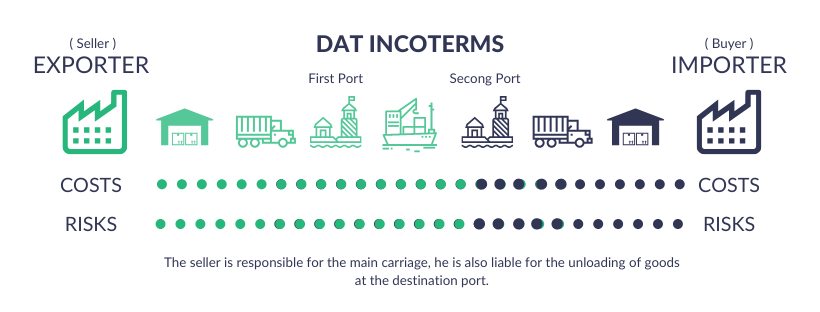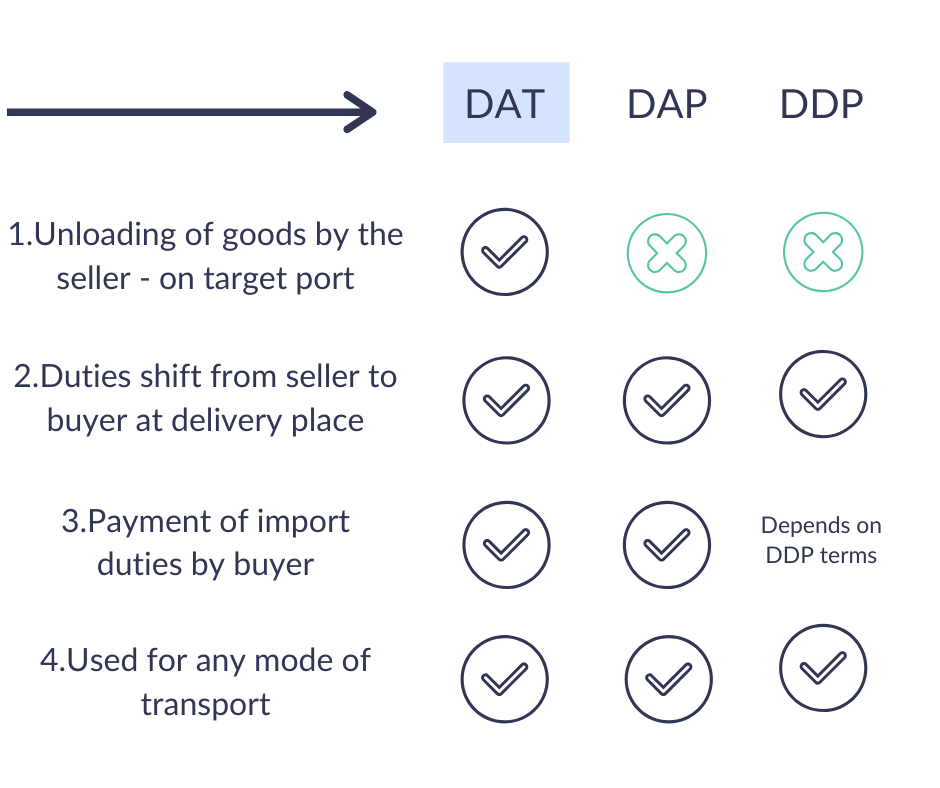The incoterm DAT, an abbreviation for Delivered-At-Terminal, was a prominent component of Incoterms 2010, the set of regulations that preceded Incoterms 2020. In Incoterms 2020, DAT was replaced by Delivered At Place Unloaded (DPU). DAT, an incoterm applied for any mode of transport, clearly specifies that the seller (or exporter or consigner) in a maritime trade transaction is responsible for arranging the export products for delivery. The security of the goods till they arrive at the end terminal in a port is the seller's responsibility.
Shipping Terms
In Delivered At Terminal, the port terminal is the nominated place of destination (in the importer’s country), which has a crucial implication in the shipping process. In DAT, the seller is responsible for the delivery of goods up to the named port, and the buyer is liable for all expenses after that juncture.

First, the nominated port or zone at the location is acknowledged by both the buyer and seller — known as the place of destination. At this port, the seller takes charge of unloading goods and the buyer looks after the import proceedings. Once the seller unloads the goods at the named port, the risk moves to the buyer.
- The seller is responsible for delivery till the named place on port. (It can also be the terminal, transport hub, forwarding agent’s warehouse, or another similar place).
- The main carriage responsibility (from the first port to the second port) rests with the seller.
- The responsibility of unloading goods at the destination port rests with the seller.
- Once the goods are unloaded at the nominated terminal, the buyer will bear the risk and costs.
For example, if DAV Ltd in New York, US, is the seller of leather shoes to KEN Enterprises in Berlin, Germany, the following will be their respective responsibilities:
Seller Responsibilities
While selling a batch of leather shoes, DAV Ltd’s responsibilities will be in terms of the following parameters:
Transportation
The seller is responsible for transporting goods until the mutually-agreed destination terminal of the selected port.
Loading and Unloading
The seller is responsible for loading the goods onto the carriage. At the nominated port/spot, the seller needs to take charge of unloading goods from the carriage.
Documents
The following documents are needed to deliver goods with the DAT incoterm:
- Export license
- Letter of instruction
- ISF filing
- Commercial invoice
- Packing list
- Bill of lading
Customs Clearance
DAT requires the seller to clear goods for export, if applicable, without any obligation to clear the goods for import, or paying import duty or execute import customs formalities.
Freight Charges
The seller bears the costs of transport, including carriage, the unloading from the main carrier at the destination, export clearance, destination port charges.
Costs Borne
Payment terms for DAV Ltd include:
- Warehouse charges: for maintaining goods till they are delivered to KEN Ltd.
- Packaging charges: for marking and labeling goods as per export standards.
- Inland transportation: for loading and transporting goods up to the first port (in the US).
- Deporting charges: for port duties to the port authorities.
- Freight forwarding charges: In case they are involved, the freight forwarding agent’s fee for handling logistics processes.
- Custom charges: for export customs proceedings at the US-based port.
- Documentation charges: DAV Ltd will bear the expenses of preparing and submitting necessary documents required for the shipping process.
Delivery terms
DAV Ltd is responsible up to the selected port (which could be in the US or Germany in this case), so they stay liable for the main freight proceedings. Their responsibility stays till the delivery of goods at the first port (in the US; the second port is the importer’s import), dealing with the documentation and shipping procedures. Further, the responsibility of unloading goods at the appointed port also rests with them.
Transfer of Risk
Once the unloading is done by the seller at the destination port, the buyer assumes the risk of the goods.
Delivery terms
DAV Ltd is responsible up to the selected port (which could be in the US or Germany in this case), so they stay liable for the main freight proceedings. Their responsibility stays till the delivery of goods at the first port (in the US; the second port is the importer’s import), dealing with the documentation and shipping procedures. Further, the responsibility of unloading goods at the appointed port also rests with them.
Insurance
Since the entire freight responsibility rests with DAV Ltd, they are also liable for insurance coverage till the nominated place of port. They will need to bear the insurance charges during the course. In this case, they will need to take marine insurance for goods.
Importer’s Responsibilities
While receiving the leather shoes, Ken Ltd has a few responsibilities of their own, and the total onus of given shipment transitions to them eventually.
Cost
Costs borne by Ken Ltd include:
- Custom charges: Ken Ltd will need to pay for import customs proceedings at their port.
- Port charges: These are the expenses for port clearing procedures in the Berlin port.
- Inland transit charges: These are the expenses for transportation from the Berlin port to Ken Ltd’s warehouse. Additionally, warehouse charges will also be borne by them for maintaining goods after the delivery of goods by the seller.
Delivery terms
Under DAT terms, Ken Ltd must accept the proof of documents provided by the seller at the destination port. They shall receive the goods delivered at the port.
Risk transfer
The risk of goods transfers to Ken Ltd after the delivery. Also, if they fail to instruct DAV Ltd in reference to the nominated port, the risk and damage will be borne by Ken Ltd.
Insurance
As the carriage duty rests with DAV Ltd, insurance is their responsibility. The buyer has no obligation to insurance.
Duty and customs clearance
As the duties transfer at the nominated harbor, the buyer is responsible for import customs and duties. They remain liable for all payment charges and risks thereafter. Acquiring all necessary documents provided by the seller at the appointed port and carrying out further import proceedings are a part of their responsibilities.
Transportation
The final transportation of goods from the specified port/terminal to the final delivery location must be done by the buyer.
Loading/Unloading
The buyer is not responsible for either the loading or unloading of goods from the carriage.
Documents
The documents provided by the seller need to be acquired by the buyer.
Freight Charges
The buyer does not have to bear any freight charges up to the destination point when the goods are unloaded by DAV Ltd.
Difference Between DAP, DAT & DDP
DAT shares several similarities with incoterms such as DAP and others. Here are some differences between the DAT and a couple of other similar-themed incoterms:

What Are the Advantages of DAT?
DAT is a highly importer-friendly incoterm. From a buyer’s perspective, they only have to receive their purchased goods once their exporter delivers the consignment at the mutually-agreed destination spot. However, the buyer pays for onward carriage and import clearance formalities.
As the seller is responsible for shipping goods to the destination terminal in the buyer’s country, the buyer has less hassle in organizing a freight forwarder.
What Are the Disadvantages of DAT?
The DAT Incoterm might also be disadvantageous to the buyers on certain occasions. For example, although the seller arranges the main carriage, the shipment costs are priced into the costs of the goods. As a result, the seller has no incentive to keep the cost of the shipment low, and the buyer usually ends up paying higher prices.
Sellers bear the bulk of responsibility as they have to arrange the entire main carriage. They also have to arrange the export customs formalities and unload the goods at the delivery terminal. When Should DAT be Used? The DAT Incoterm is most suitable for containerized freight where the seller bears responsibility for the main carriage.
As the seller is responsible for the main carriage, it is in their best interest to obtain insurance for the voyage to cover any loss or damage to the goods.
When Should DAT be Used?
The DAT Incoterm is most suitable for containerized freight where the seller bears responsibility for the main carriage.
As the seller is responsible for the main carriage, it is in their best interest to obtain insurance for the voyage to cover any loss or damage to the goods.
FAQs on DAT Incoterms
Does DAT include duty?
Yes, DAT does include customs duty, but both the parties have to contribute towards it. The seller has to take care of export duty and the buyer has to take care of import.
Does DAT include unloading?
The seller has to take care of unloading of goods at the destination port as per DAT.



